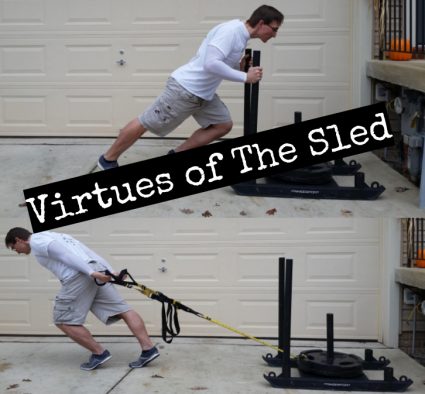
CrossFit didn’t invent the sled.
But they sure as hell made it popular.
I first heard about sled dragging from reading ancient T-Nation and Westside articles.
Like most things “strength” today, Louie and the guys at Westside were dragging sleds LONG before just about anyone else.
It seemed like any problem you had:
- Fat
- Out of Shape
- Weak
- You’d get the “shakes” when you would get under a squat bar
All of these things were,cured by copious amounts of sled dragging, according to this mad man:
This is NSFW
I still don’t know how the hell dragging a sled, no matter how much weight is on it, can stop you from shaking under a really heavy squat, but if Lou says so….
Then around 2004 or 05 this thing called the Prowler came out and was made famous by Joe D’s now infamous “Prowler Flu” video.
That’s about when sled pushing and pulling started to become a thing and then, CrossFit hit, folks were “sledding” all the time.
Now the sled is a common piece of equipment in most gyms.
The Virtues of the Sled
No Soreness:
Pushing or pulling, there’s no eccentric muscle (lengthening against resistance) action.
The eccentric is generally considered to be what creates the most muscle damage and subsequent muscle soreness.
Keep in mind, this isn’t ZERO muscle damage, but much less.
So even though your legs burn (metabolic stress) you’re probably not going to feel it too much the next day.
Except the Calves/ Achilles:
There is a pretty large eccentric/ Isometric on muscles of/ that cross the ankle joint.
It’s really an eccentric, because at the point of contact, the ankle IS going into dorsiflexion, at least a little.
Think of it like tennis elbow.
It gets its name from tennis. <—captain obvious.
When you make contact with the ball there is (hopefully only a tiny) eccentric on the forearm extensors at the moment of contact.
Even through YOU don’t feel the racquet move and bend back, there is a force on the muscles, from the ball hitting the racquet, trying to pull them/ the wrist backwards.
That’s what happening to your ankle at the point of contact with the ground.
Just keep that in mind.
You can end up with some hella sore calves and ankles the next day after the first time.
Sleds are Really User Friendly:
It’s pretty hard to do anything that would screw you up.
It’s pretty hard not to get the technique correct after about 5 minutes.
Once you find the “line” your brain kinda goes, “ohh, hey dumbass, you should have done that the whole, time. Do that from now on”.
From there, you’ll pretty much understand and have perfect technique.
Easy on the Low Back:
Unless you get into a big reverse C (lumbar hyperextension) low back position you’re not going to be loading the low back very much.
What the Hard “C” Looks Like
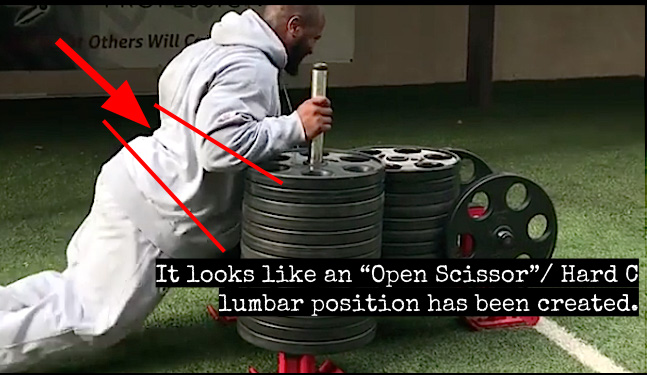 Probably not the best position to be in if we’re trying to maintain a neutral lumbar spine and keep pressure off the low back.
Probably not the best position to be in if we’re trying to maintain a neutral lumbar spine and keep pressure off the low back.
Let’s Pause for a Lesson In Context:
*Editors Note:
James Harrison is a future NFL Hall of Famer.
His ability to push a sled is impressive AF, and usually dead on point, which is AMAZING considering the copious amounts of weight he moves with relative ease.
This was just a good example of the “C” lumbar position ( you can actually see it develop at 5 seconds in), we all have crappy technique at times, it happens.
BUT, because he is an absolute #freakbeast / master of movement, he figures it out and CORRECTS the exaggerated “C” posture on the move (12 seconds in) and achieves a neutral spine, WHILE PUSHING A F@CKING TON OF WEIGHT .
Truthfully, I’ve never had someone complain about back pain with the sled, but I’m guessing that if you use that hard C to gain stability while pushing the sled, you would be in a bad way at some point.
In fact sled work is pretty much my go-to when someone complains of low back pain with lower body lifting.
Makes “Conditioning” Tolerable:
It’s “cardio”, but how?
It’s lifting weights, but not?
With the sled its really easy to manage heart rate and switch between upper and lower, pushing and pulling, etc to stay in your training zone and get the desired effect.
There are probably hundreds of exercises you can do with the sled as long as you have dragging straps of some sort attached.
Basically, it’s not so damn mindless and boring as your typical cardio.
IMO, you just feel like you’re doing “more” for your #gainzz than if you were just doing traditional “cardio”.
Target Weak Points:
Remember how there’s little to no muscle damage?
Remember how sled is easy to recover from?
But there IS muscle activation…
Put those 3 together and sled work is perfect to get in extra work to bring up weak points.
Weak hamstrings?
Do hamstring walks, Pullthroughs, Forward Dragging
Weak Quads?
Need More Tri’s?
Get the point?
Sled work is almost literally free training volume.
*A note on the above:
I think sled work in this regard, as extra volume, is more of an additive effect.
I DO NOT think it’s a good primary form of “stress” if you’re trying to get bigger or stronger, but can be ADDITIVE if you’re already putting in the work using traditional strength training methods.
Sledding Dragging 101
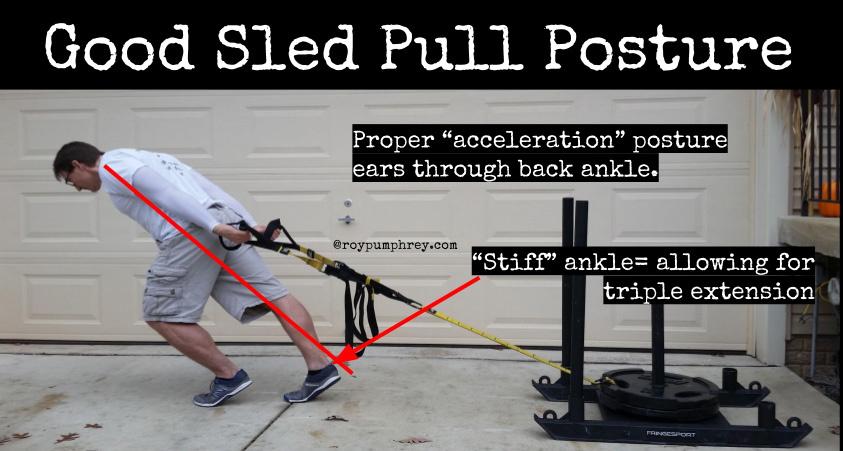 Checklist:
Checklist:
Keep a Good “Acceleration” Posture.
- Neutral Low back
- Bottom Rib Down
- “Stiff”/ Active ankles <—don’t get flat-footed.
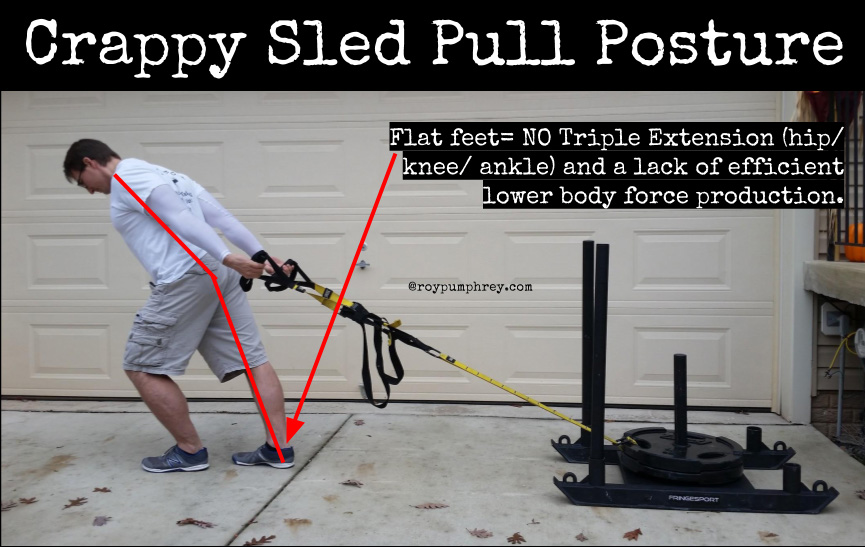
Sled Pushing 101
Basically, it’s all the same stuff.
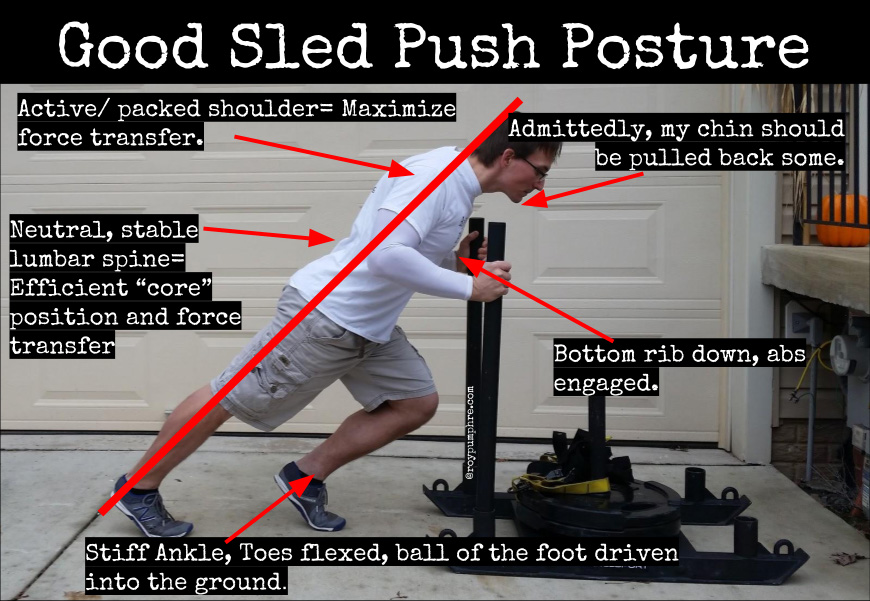 Checklist:
Checklist:
- Ribcage down
- Shoulders “tight” in the joint
- Active ankles


